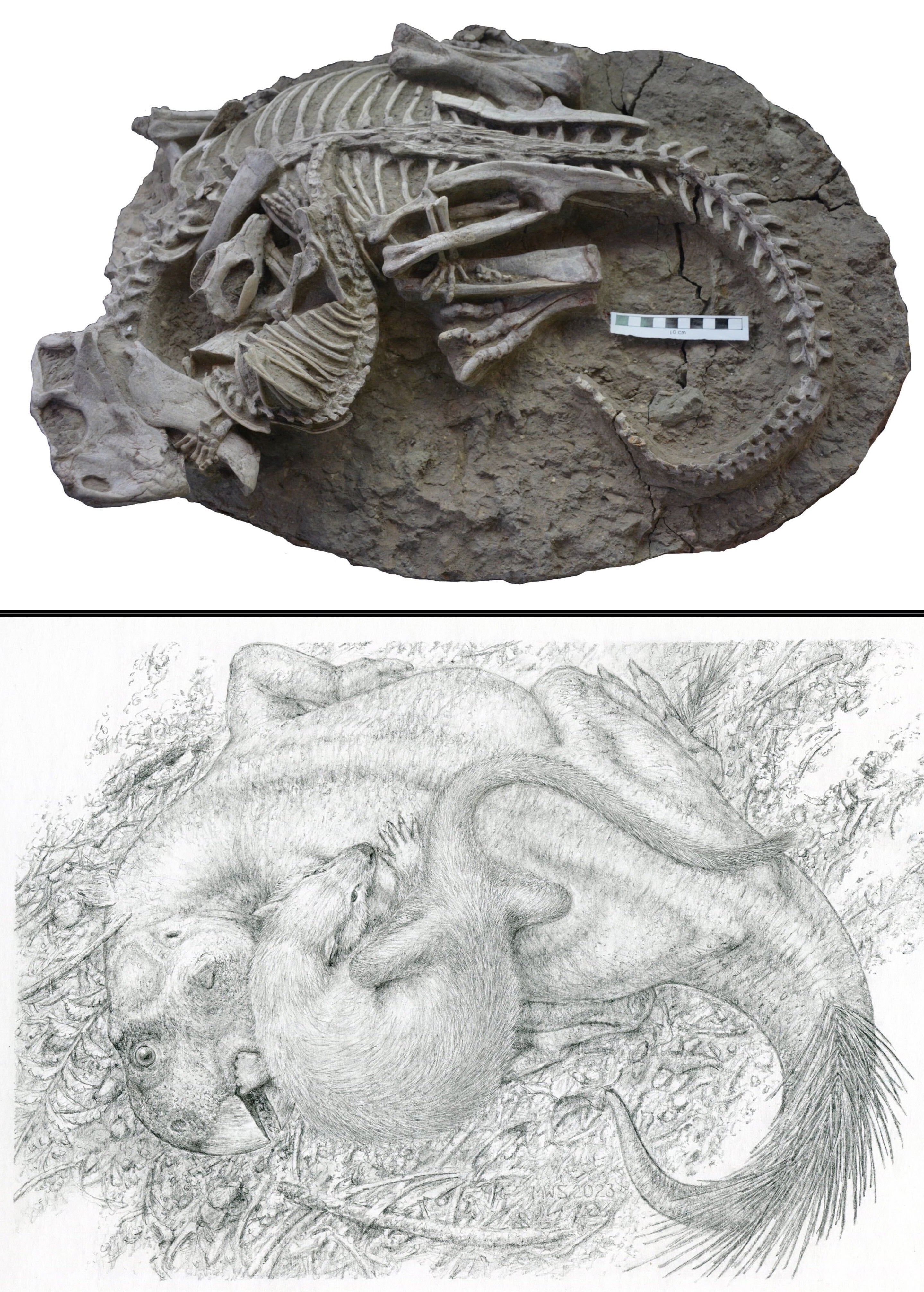An extraordinary fossil captures the moment when a hungry mammal attacked a dinosaur
Thank you for reading this post, don't forget to subscribe!
Since the Triassic period 230 million years ago, mammals have lived alongside dinosaurs—and later with their descendants, birds. Mammals and dinos have rarely been on an even playing field, however. Until an asteroid strike doomed the nonavian dinosaurs 66 million years ago, most mammals were pint-sized critters that ate insects and seeds and scurried in the shadow of supersized reptiles. Even the largest Mesozoic mammals maxed out at the size of a badger.
This made Repenomamus robustus a mammalian giant for its day. It tipped the scale at around 10 pounds and belonged to a now extinct family of carnivorous mammals that experienced their heyday during the Early Cretaceous.
Repenomamus’s taste for dinosaur flesh is not entirely surprising. In 2005 researchers examining a Repenomamus fossil discovered the tiny bones of a young Psittacosaurus, an early relative of herbivores such as Triceratops, lodged in the mammal’s stomach. More fossils were needed, however, for scientists to determine whether Repenomamus actively hunted larger dinosaurs or just snacked on defenseless baby dinos.

The new find hails from a fossil-rich site in China’s Liaoning Province, in an area sometimes called the “Chinese Pompeii.” During the Early Cretaceous, the area’s volatile volcanoes buried myriad creatures, including feathered dinosaurs and early tyrannosaurs, in debris. This preserved many of the region’s prehistoric inhabitants in three dimensions, offering paleontologists detailed snapshots of this ancient ecosystem.
The new study’s fossilized brawl was uncovered in 2012 by a local farmer and was soon acquired by Gang Han, a paleontologist at China’s Hainan Vocational University of Science and Technology. To describe the remarkable find, Han teamed up with colleagues in Canada. “My eyes just about popped out of my head when I was shown the fossil,” says study co-author Jordan Mallon, a paleontologist at the Canadian Museum of Nature in Ontario.
Save for the tip of Repenomamus’s tail, both skeletons are complete and remain locked in eternal mortal combat. This initially seemed too good to be true, according to Mallon. Some fossil dealers in the area are known to cobble together disparate bones to craft dramatic set pieces, but many of these forgeries are simple, side-by-side juxtapositions nowhere near as complex as the intertwined Repenomamus and Psittacosaurus skeletons. “We confirmed that the left lower jaw of the mammal does indeed plunge into the rock to clench the ribs of the dinosaur,” Mallon says. “I don’t know how you fake that.” An analysis of the surrounding rock also indicated the two creatures were likely buried together in the locale where the fossil was discovered.
The researchers, confident the fossil was genuine, next examined the petrified combatants. Though it was clear Repenomamus was the aggressor based on its position atop the dinosaur, the group needed to confirm that the pugnacious predator was not simply scavenging a Psittacosaurus carcass when disaster struck. The scientists found little evidence of tooth marks on the dinosaur’s skeleton beyond the ribs Repenomamus had clamped down on. This made it unlikely that the Psittacosaurus had been previously scavenged. The tangled nature of the two skeletons, as well as the mammal’s position—it could have easily gorged itself from ground level if the dinosaur was already dead—seemed to also support the theory that this was an active hunt.
Based on the size of its bones, the researchers estimated that the Psittacosaurus was nearly full-grown when Repenomamus attacked. It could have weighed more than 35 pounds, making it at least three times larger than its assailant. To determine if pursuing such large game was plausible, the team created a computer model comparing predator and prey sizes across living mammals. This data set included modern-day carnivorous predators such as wolverines, which have been known to attack prey several times their size—including moose and reindeer. Based on their model, the researchers concluded that a hungry Repenomamus could target a large Psittacosaurus. “Pound-for-pound, these Mesozoic mammals could be pretty feisty,” Brusatte says.
Though dinosaurs appear to have been on the menu for some early mammals, Mallon stresses that the majority of Mesozoic mammals were much more susceptible to becoming a dinosaur’s dinner than the other way around. It would take tens of millions of years and an asteroid strike for mammals to realize their full ecological potential at the top of the food chain. “I think of this little guy as a sort of forerunner,” Mallon says, “letting the dinosaurs know that their time is almost up!”
ABOUT THE AUTHOR(S)
Jack Tamisiea is a science journalist based in Washington, D.C., who covers natural history and the environment. Follow Tamisiea on Twitter @jack_tamisiea

